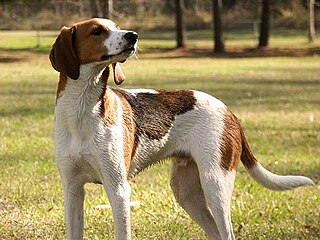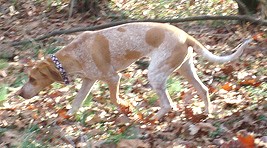
The beagle is a breed of small scent hound, similar in appearance to the much larger foxhound. The beagle was developed primarily for hunting hare, known as beagling. Possessing a great sense of smell and superior tracking instincts, the beagle is the primary breed used as a detection dog for prohibited agricultural imports and foodstuffs in quarantine around the world. The beagle is a popular pet due to its size, good temper, and a lack of inherited health problems.

The Harrier is a medium-sized dog breed of the hound class, used for hunting hares by trailing them. It resembles an English Foxhound but is slightly smaller, though not as small as a Beagle. The breed has been used since the mid 13th century.

The Great Dane is a large-sized dog breed originating from Germany. The Great Dane descends from hunting dogs from the Middle Ages used to hunt wild boar and deer, and which were also used as guardians of German nobility. It is one of the two largest (tallest) dog breeds in the world, along with the Irish Wolfhound. However, other breeds like the St. Bernard or English Mastiff are often heavier.

The Catahoula Leopard Dog is an American dog breed named after Catahoula Parish, Louisiana. It became the state dog of Louisiana in 1979. It is recognized by the United Kennel Club under the name Louisiana Catahoula Leopard Dog, while the American Kennel Club Foundation Stock Service calls it Catahoula Leopard Dog. Both registries have assigned the breed a herding group designation, although it has traditionally been used in hunting feral boars.

Scent hounds are a type of hound that primarily hunts by scent rather than sight. These breeds are hunting dogs and are generally regarded as having some of the most sensitive noses among dogs. Scent hounds specialize in following scent or smells. Most of them tend to have long, drooping ears and large nasal cavities to enhance smell sensitivity. They need to have relatively high endurance to be able to keep track of scent over long distances and rough terrain. It is believed that they were first bred by the Celts by crossbreeding mastiff-type dogs with sighthounds. The first established scent hounds were St. Hubert Hounds bred by monks in Belgium during the Middle Ages.

The Rhodesian Ridgeback is a large dog breed originally bred in Southern Africa. Its forebears can be traced to the semi-domesticated ridged hunting and guardian dogs of the Khoikhoi. These were interbred with European dogs by the early colonists of the Cape Colony for assisting in the hunting of lions.

The Black and Tan Coonhound is a breed of hunting dog. Developed in the United States from crosses between the Bloodhound and the Black and Tan Virginia Foxhound, this scent hound runs its game entirely by scent and is used primarily for raccoon hunting.

A coonhound, colloquially a coon dog, is a type of scenthound, a member of the hound group. They are an American type of hunting dog developed for the hunting of raccoons, hence their name, and also for feral pigs, bobcats, cougars, and bears. There are six distinct breeds of coonhound.

The Boxer is a medium to large, short-haired dog breed of mastiff-type, developed in Germany. The coat is smooth and tight-fitting; colors are fawn, brindled, or white, with or without white markings. Boxers are brachycephalic, have a square muzzle, mandibular prognathism, very strong jaws, and a powerful bite ideal for hanging on to large prey. The Boxer was bred from the Old English Bulldog and the now extinct Bullenbeisser, which became extinct by crossbreeding rather than by a decadence of the breed. The Boxer is a member of both The Kennel Club and American Kennel Club (AKC) Working Group.

The Bluetick Coonhound is a breed of coonhound originating in the United States. The Bluetick Coonhound is known for its friendly personality, cold nose, and deep bawl mouth. It is most commonly used as a raccoon hunting dog, but may also be kept as a pet.

Collies form a distinctive type of herding dogs, including many related landraces and standardized breeds. The type originated in Scotland and Northern England. Collies are medium-sized, fairly lightly-built dogs, with pointed snouts. Many types have a distinctive white color over the shoulders. Collies are very active and agile, and most types of collies have a very strong herding instinct. Collie breeds have spread through many parts of the world, and have diversified into many varieties, sometimes mixed with other dog types.

The Weimaraner is a large dog that was originally bred as a hunting dog in the early 19th century. Early Weimaraners were used by royalty for hunting large game such as boar, bear and deer. As the popularity of hunting large game began to decline, Weimaraners were used for hunting smaller animals like fowl, rabbits and foxes.

The Treeing Walker Coonhound is a breed of hound descended from the English and American Foxhounds. The breed originated in the United States when a stolen dog known as "Tennessee Lead" was crossed into the Walker Hound in the 19th century. The Treeing Walker Coonhound was recognized officially as a breed by the United Kennel Club in 1945 and by the American Kennel Club in 2012.

The Drever is a breed of dog, a short-legged scenthound from Sweden used for hunting deer and other game. The Drever is descended from the Westphalian Dachsbracke, a type of German hound called Bracke. The breed name Drever was chosen through a contest in 1947.

The Transylvanian Hound is a dog breed originating from Hungary and Transylvania and was historically primarily used for hunting. It is a strong, medium-sized scent hound, characterized by a black body, with tan and sometimes white markings on the muzzle, chest and extremities, and distinctive tan eyebrow spots. It has a high-pitched bark for a dog of its size. The breed was rescued from extinction by focused breeding efforts in the late 20th century. There were formerly two varieties, the tall and the short, developed for different kinds of hunting in the Middle Ages. Only the tall variety survives today.

The American English Coonhound, also referred to as the English Coonhound or the Redtick Coonhound, is a breed of coonhound that originated in and is typically bred in the Southern United States. It is descended from hunting hounds, especially foxhounds, brought to America by settlers during the 17th and 18th centuries. The breed's first recognition came from the United Kennel Club in 1905 as the English Fox and Coonhound. Further recognition has been granted in recent years by the American Kennel Club, first in the Foundation Stock Service and in 2011 as a fully recognized member of the hound group.

The American Leopard Hound is an American breed of hunting dog. It is recognized by the United Kennel Club (UKC) as a scenthound and is in the American Kennel Club's Foundation Stock Service.

The Slovenský kopov is a medium-sized breed of hunting dog of the scenthound type. The breed originated in Slovakia, in Central Europe, and is bred for deer tracking and boar hunting. The name Black Forest Hound seems to have been created in North America for marketing purposes, since the breed has no connection with the Black Forest. The German name for this breed is Schwarzwildbracke which translates to Wild Boar Hound and not Schwarzwaldbracke which would be Black Forest Hound.

The Grand Anglo-Français Blanc et Noir translated into English as the Great Anglo-French White and Black Hound, is a breed of dog used in hunting as a scenthound, usually in packs. It is one of the Anglo-French hound breeds which were created by crossing French scenthounds with English (Anglo) Foxhounds.

The Grand Anglo-Français Blanc et Orange translated into English as the Great Anglo-French White and Orange Hound, is a breed of dog used in hunting as a scenthound, usually in packs. It is one of the Anglo-French hound breeds which were created by crossing French scenthounds with English (Anglo) foxhounds.




















